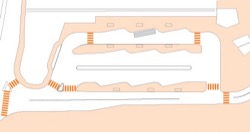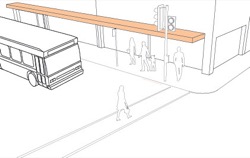On this page:
What is a railway station precinct?
A railway station precinct is the area in the immediate surrounds of a railway station. Local movement networks converge on railway stations, concentrating activity in the precinct. Railway stations also provide for pedestrian crossing of the railway line.
The railway station precinct can function as a social space where people meet or watch the world go by. Railway stations are located in a number of different settings – activity centres, residential neighbourhoods, semi-rural or industrial – resulting in different levels of activity and use patterns in each precinct.
Where a railway station is co–located with other uses and facilities, activity may be spread over more of the day. Where a station stands alone, activity may have temporal peaks, often resulting in patchy activation through the day. Where present, station and ancillary staff can provide informal surveillance in the station area.
Why is it important?
Railway stations attract a wide range of travellers and commuters who arrive or depart on foot, by car, bus, tram, or bicycle, and who wait or change modes. Station buildings also may be used for community activities.
This element provides design guidance for the immediate surroundings of railway stations. It does not include design considerations within the paid (ticketed) area. The engineering, servicing or management issues of public transport are guided by other appropriate authorities. Refer to Public Transport Guidelines for Land Use and Development.
4.3.1: provide functional and safe movement within public transport interchanges
Public transport interchanges function well when centrally located with direct and separated access lanes for public transport vehicles. Refer to 1.2 Activity centre structure for location and access guidance for public transport interchanges.
- Within public transport interchanges, provide pedestrian paths separated from the vehicle lanes.
- Where a bus interchange is arranged as parallel ranks, provide direct, dedicated pedestrian paths and crossings over bus lanes or roads.

Tip: when pedestrian paths and crossings are located in inconvenient places, pedestrians may cross roads informally and put themselves at risk. - Where a bus interchange is linear along a street edge, provide a continuous, unobstructed passenger shelter.

Tip: shelter structures and other obstructions must be clear of pedestrian and vehicle travel paths, and meet requirements for disability access.
4.3.2: ensure the public transport interchange protects the amenity of adjacent sensitive uses
- Locate active, non-residential uses on the interface with public transport interchanges, and locate more sensitive uses away from the interchange area.
Tip: bus and tram interchanges generate many vehicle movements and operate from early morning to late night. Noise and light may disturb sensitive uses nearby if located close to an interchange.
Page last updated: 09/06/23